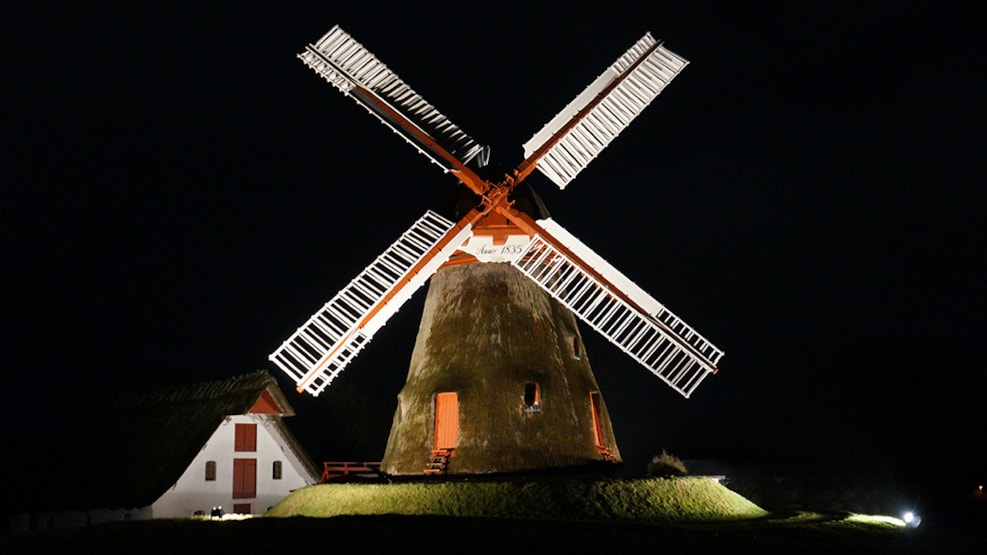
Havnbjerg Mølle - history
Fully thatched windmill of Dutch type, built in 1835 and situated on a high hilltop with the church of Havnbjerg as a neighbour.
Most mills have had one or more predecessors, and Havnbjerg Mølle is no exception. According to old oral accounts, there was originally a watermill at the forest Havnbjerg Skov near the coast.
The watermill was later replaced by a post mill on the mill hill near the church, and one of the beams in the old post mill bore the date 1612. When Johannes Mejer drew a detailed map of the area in 1649, no watermill was marked, so it was probably dismantled to reuse the timber and stones elsewhere.
In 1694, Duke August of Østerholm transferred Havnbjerg Mølle as a ducal hereditary mill to Andreas Møller, who ran it until 1723, when it was taken over by his son, Hans Rasmussen Møller. When Duke Frederik Karl of Nordborg took over the fiefdom in Plön, he ceded the principality of Nordborg to King Frederik IV.
During a violent October storm in 1776, the stump mill was knocked over and replaced by a similar mill, built from timber from Havnbjerg Skov, which remained in operation until 1836. Havnbjerg Mølle can be traced through correspondence from the royal houses since 1729, when in 1796 it received permission from Christian VII to build a grain and grub mill, and Frederik VI confirmed the mill's rights in 1813.
In 1835, the current Dutch mill was built, and the last royal confirmation of the transfer of privileges was given by King Frederik VII in 1860 to Peter Johannsen, who, upon incorporation into Prussia after the loss of the war in 1864, received confirmation from the government of Schleswig that all rights would continue to apply under the new regime. However, the mill privilege had already ceased in 1862, so when it became possible, the Johannsen family purchased Havnbjerg Mølle.
Like other windmills, it kept up with the times, and in 1907 Havnbjerg Mølle was equipped with a wind rose and the sails of the blades were replaced with flaps. The thatched roof needed renewal in 1923, when the cheaper solution of zinc sheets was chosen, and in 1934 steam power was installed.
Havnbjerg Mølle remained in operation until 1961, when the wind changed direction so quickly during a stormy night that the wind rose did not have time to turn the blades and the cogwheel was destroyed. In 1964, the mill was listed as a protected building, as it was considered extremely worthy of preservation – especially if it could be re-thatched.
This is when manufacturer Mads Clausen stepped in. After purchasing the mill and the mill house, he initiated an extensive restoration, in which the mill was not only covered with thatch, but also retained the somewhat more expensive solution with jalousie blades and a wind rose, so that it could still yaw automatically (turn the blades in relation to the wind).
Unfortunately, neither the last miller, Peter Johannsen, nor Mads Clausen lived to see the reopening on 10 November 1967. The foundation Mads Clausen Fond took over the mill in 1969 and is responsible for its maintenance and operation as a museum, while the Danish Forest and Nature Agency, Skov- og Naturstyrelsen, contributes to its renovation.
The above information is a summary of ‘Vindmøller og Vandmøller i Danmark’ by Anna Maria Lebech and ‘Møller på Als’ by Hans Linow and Jens Lampe.
For opening hours, see Havnbjerg Mølle Museum.